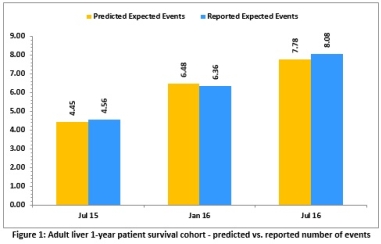Using the SRTR Expected Survival Worksheet to Estimate Expected Number of Events
1Division of Nephrology, Hypertension, and Renal Transplantation, University of Florida, Gainesville, FL
2Department of Surgery, University of Florida, Gainesville, FL.
Meeting: 2018 American Transplant Congress
Abstract number: 580
Keywords: Graft survival, Resource utilization, Risk factors
Session Information
Session Name: Concurrent Session: Quality Assurance Process Improvement
Session Type: Concurrent Session
Date: Tuesday, June 5, 2018
Session Time: 4:30pm-6:00pm
 Presentation Time: 4:54pm-5:06pm
Presentation Time: 4:54pm-5:06pm
Location: Room 2AB
The purpose of this effort is to provide transplant administrative and clinical directors with reliable predictions of Scientific Registry of Transplant Recipients (SRTR) risk-adjusted 1-year expected number of events – to be published in forthcoming Program Specific Reports (PSRs).
Using data provided by the United Network for Organ Sharing (UNOS), statistical software is programmed to emulate, for a specific cohort of transplant patients, the applicable SRTR Risk Adjustment model. The program calculates each patient's unique set of risk-adjustors, and renders them into spreadsheet form. With all of the risk-adjustors at hand, a simple editing of the most recent SRTR Expected Survival Worksheet (ESW) allows patients to be added (e.g. a new 6 months' worth of transplants), and to be omitted (the oldest 6 months), thus enabling the formation of cohorts that will be reported on in future PSRs.
The estimation method described was implemented fairly recently, and consequently only a few PSR's worth of longitudinal information on its predictive effectiveness exists at this time. What data has been generated, however, indicates a reasonably close estimation of the actual, SRTR-reported expected number of events is being obtained (see Figure 1). We have used it for heart, kidney, liver, and lung. 
Adding patients to the SRTR's dynamic Expected Survival Worksheet (to form future cohorts) provides estimations of outcomes and applies them to current regulatory criteria used by the Centers for Medicare and Medicaid Services, and the OPTN's Membership and Professional Standards Committee. The results are displayed with sophisticated charts and color-coded graphics. The sheet also enables transplant center leadership to engage in hypothetical modeling, adding events likely to happen, or changing high value donor and recipient covariates that impact risk adjustment. Accuracy is also increased, as much of the data employed by the sheet is exactly that used by the SRTR. Using this method to predict expected events comes reasonably close to those actually reported by the SRTR.
CITATION INFORMATION: Gregg J., Womer K., Andreoni K. Using the SRTR Expected Survival Worksheet to Estimate Expected Number of Events Am J Transplant. 2017;17 (suppl 3).
To cite this abstract in AMA style:
Gregg J, Womer K, Andreoni K. Using the SRTR Expected Survival Worksheet to Estimate Expected Number of Events [abstract]. https://atcmeetingabstracts.com/abstract/using-the-srtr-expected-survival-worksheet-to-estimate-expected-number-of-events/. Accessed November 25, 2025.« Back to 2018 American Transplant Congress
